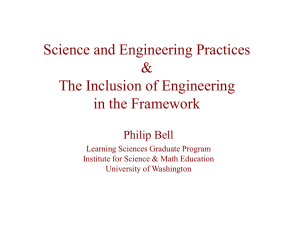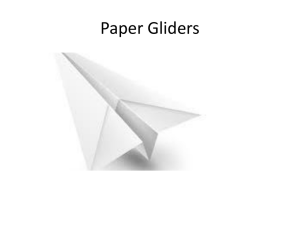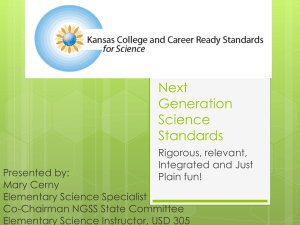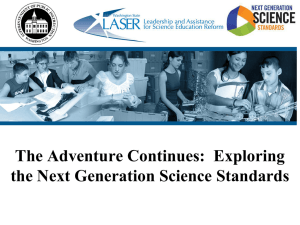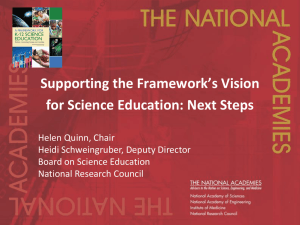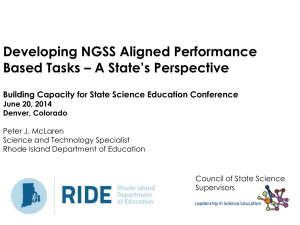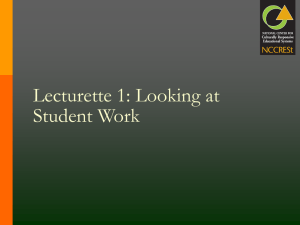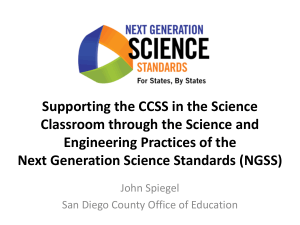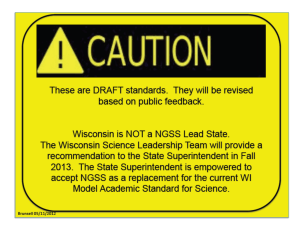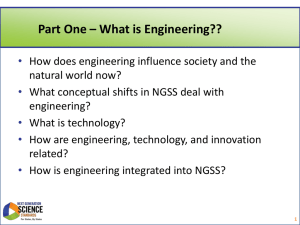CMT and CAPT Science
advertisement
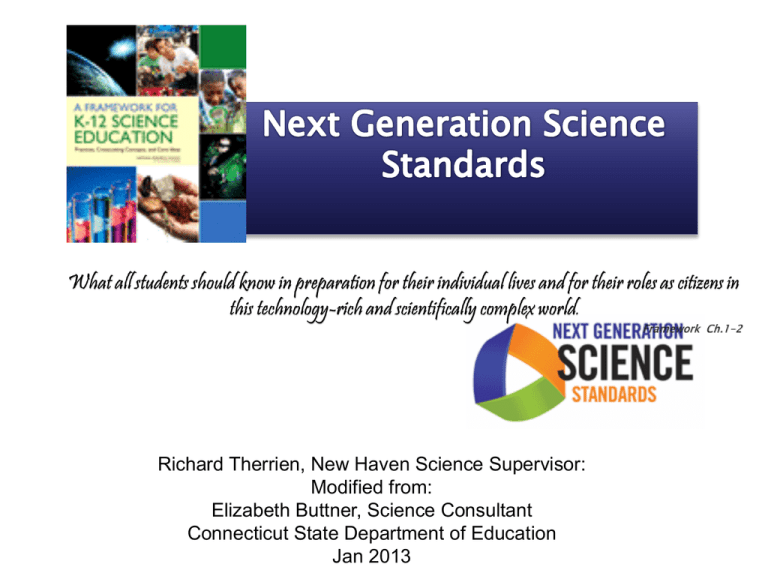
Richard Therrien, New Haven Science Supervisor: Modified from: Elizabeth Buttner, Science Consultant Connecticut State Department of Education Jan 2013 4/13/2015 1 NRC Framework ◦ Vision ◦ 3 Dimensions ◦ Key “shifts”, practices NGSS (standards) Draft ◦ Format/ Scope ◦ Early reviews Transition 4/13/2015 2 States “cherry-picked” to write their own standards ◦ Result: a national hodge-podge of varied rigor and clarity Varied treatment of “politicized” issues Too much content to be learned well Inquiry widely interpreted; separated from content Bottom line: inconsistency and limited improvement in 15 years (NAEP and TIMSS) 4/13/2015 3 Lessons learned since NSES and AAAS Need for greater coherence New research on how students learn science International rankings on TIMSS and PISA Era of common standards and assessments 4/13/2015 4 NRC Framework: NGSS Standards: Broad Goals Specific Goals Curriculum: How Goals Will Be Reached * Teaching Materials * PD * Teacher Prep * Assessments 4/13/2015 5 Phase1: National Research Council develops a K-12 Framework. Published 7-18-11 ◦ Project description and Framework download or purchase: http://www.nap.edu/catalog.php?record_id=13165 Phase 2: Achieve Inc. coordinates standards writing; Completion early 2013 NOT called “Common Core” ◦ Standards written first; then states choose to adopt ◦ No federal money to entice adoption 4/13/2015 6 • National Academy of Science: Imperative to “get the science right” • Written by committees of expert scientists, science educators, cognitive scientists • Bundles best pieces of earlier standards initiatives • Guidelines for standards writers coordinated by Achieve 4/13/2015 7 Research underlying NRC Framework for K-12 Science Education 4/13/2015 8 A Framework for K-12 Science Education: Practices, Crosscutting Concepts, and Core Ideas 4/13/2015 9 INTEGRATION: Content, Practice and Crosscutting Concepts are integrated in instruction and in assessment ENGINEERING: Engineering Design, Technology and Applications of Science are integrated within science lessons PRACTICES: Shift from “inquiry” to “practices” : ◦ More emphasis on higher order thinking (e.g., modeling, designing, making evidence-based claims, critiquing arguments); ◦ Less emphasis on experimenting, naming variables, process skills COHERENCE: Learning progresses over time across grades APPLICATION OF CONTENT: Stronger focus on how science is applied through engineering and technology innovations 4/13/2015 10 “Students, over multiple years of school, actively engage in science and engineering practices and apply crosscutting concepts to deepen their understanding of each fields’ disciplinary core ideas.” Framework Ch.1 11 1. 2. 3. 4. 5. 6. Young children can reason in sophisticated ways; building progressively more complex scientific explanations of natural phenomena begins in K-5 Understanding core ideas by engaging in scientific and engineering practices prepares students for broader understanding later on Developing understanding of scientific explanations requires sustained exposure to core ideas over years rather than weeks or months Science and engineering involve both knowledge and a set of practices Science learning needs to connect with students’ interests and experiences Equity requires that all students have opportunities to learn science and become engaged in science and engineering practices Framework Ch. 2 4/13/2015 12 1. Asking questions and defining problems 2. Developing and using models 3. Planning and carrying out investigations 4. Analyzing and interpreting data 5. Using mathematics and computational thinking 6. Developing explanations and designing solutions 7. Engaging in argument from evidence 8. Obtaining, evaluating, and communicating information 4/13/2015 13 Ch. 3-1: A narrow focus on content alone has the unfortunate consequence of leaving students with naive conceptions of the nature of scientific inquiry and the impression that science is simply a body of isolated facts. Ch. 3-1: As previously noted, we use the term “practices,” instead of a term such as “skills,” to stress that engaging in scientific inquiry requires coordination both of knowledge and skill simultaneously. Ch. 3-2: …a focus on practices (in the plural) avoids the mistaken impression that there is one distinctive approach common to all science—a single “scientific method”—or that uncertainty is a universal attribute of science. In reality, practicing scientists employ a broad spectrum of methods… 4/13/2015 14 Ch. 3-2: …Minimize the tendency to reduce scientific practice to a single set of procedures, such as identifying and controlling variables, classifying entities, and identifying sources of error. This tendency overemphasizes experimental investigation at the expense of other practices, such as modeling, critique, and communication. In addition, when such procedures are taught in isolation from science content, they become the aims of instruction in and of themselves rather than a means of developing a deeper understanding of the concepts and purposes of science. 4/13/2015 15 Ch. 3-2: The focus here is on important practices, such as modeling, developing explanations, and engaging in critique and evaluation (argumentation), that have too often been underemphasized in the context of science education. In particular, we stress that critique is an essential element both for building new knowledge in general and for the learning of science in particular. …what data are reliable and relevant …which explanation is the most satisfactory. Thus knowing why the wrong answer is wrong can help secure a deeper and stronger understanding of why the right answer is right. 4/13/2015 16 Focus not just on “investigation of hypotheses” but on building ideas -- making sense of findings, using results to develop models, argue competing explanations and reach consensus Includes collaboration and discourse elements of working together to develop scientific knowledge 1. Asking questions and defining problems 5. Using mathematics and computational thinking 2. Developing and using models 6. Developing explanations and designing solutions 3. Planning and carrying out investigations 4. Analyzing and interpreting data 7. Engaging in argument from evidence 8. Obtaining, evaluating, and communicating information Making thinking visible through writing and classroom discourse is an important way to provide models for students’ expectations of engaging in science and engineering practices. The practices make the science classroom more science-like. It is essential that the questions posed by teachers engage students and provide opportunities to inform instruction. 4/13/2015 18 Develop, test, and refine scientific explanations, models, and theories Cognitive work: ◦ Steps to gather evidence, build explanation ◦ Criteria to guide and evaluate (understanding of science) Social interaction: How to interact with others to do the scientific work Discourse: How to communicate about the science 4/13/2015 20 4/13/2015 21 Physical Sciences Life Sciences Matter & its Interactions Structures & Processes Motion & Stability: Forces & Interactions Ecosystems: Interactions, Energy & Dynamics Energy Heredity: Inheritance of Traits Waves & Their Applications in Technologies for Info Transfer Earth & Space Sciences Earth’s Place in the Universe Earth’s Systems Engineering, Technology & Applications of Science Engineering Design Links Among Engineering, Technology, Science and Society Earth & Human Activity Biological Evolution 4/13/2015 22 LS1 LS2 LS3 LS4 Ecosystems Heredity Biological Evolution A: Structure and Function A: Interdependent Relationships in Ecosystems A: Inheritance of Traits A: Evidence of Common Ancestry and Diversity B: Growth and Development of Organisms B: Cycles of Matter and Energy Transfer in Ecosystems B: Variation of Traits B: Natural Selection C: Organization for Matter and Energy Flow in Organisms C: Ecosystems Dynamics, Functioning and Resilience C: Adaptation D: Information Processing D: Social Interactions and Group Behavior D: Biodiversity and Humans Structures and Processes 4/13/2015 23 ESS1: Earth’s Place in the Universe A: The Universe and Its Stars B: Earth and the Solar System ESS2: Earth’s Systems A: Earth Materials and Systems B: Plate Tectonics and Large Scale System Interactions C: The Roles of Water in Earth’s Surface Processes C: History of Planet Earth D: Weather and Climate ESS3: Earth and Human Activity A: Natural Resources B: Natural Hazards C: Human Impacts on Earth Systems D: Global Climate Change E: Biogeology 4/13/2015 24 PS1 Matter and its Interactions PS4 PS2 Motion and Stability: Forces and Interactions PS3 Energy Waves and Their Applications in Technologies for Information Transfer A: Structure and Properties of Matter A: Forces and Motion A: Definitions of Energy A: Wave Properties B: Chemical Reactions B: Types of Interactions B: Conservation of Energy and Energy Transfer B: Electromagnetic Radiation C: Nuclear Processes C: Stability and Instability in Physical Systems C: Relationship Between Energy and Forces C: Information Technologies and Instrumentation D: Energy in Chemical Processes and Everyday Life 4/13/2015 25 ETS2 ETS1 Engineering Design Links Among Engineering, Technology, Science and Society A: Defining and Delimiting and Engineering Problem A: Interdependence of Science, Engineering, and Technology B: Developing Possible Solutions B: Influence of Engineering, Technology, and Science on Society and the Natural World C: Optimizing the Design Solution 4/13/2015 26 NRC Framework Patterns Cause/Effect Scale, Proportion, Quantity Systems & system models Energy & matter Structure & function Stability & change NSES Unifying Themes Systems, order, and organization Evidence, models, and explanation Change, constancy, and measurement Evolution and equilibrium Form and function AAAS Common Themes Systems Models Constancy and change Scale 4/13/2015 27 4/13/2015 28 Funded by a grant from Carnegie Corporation – no federal funds or incentives Development coordinated by Achieve; supported by NSTA, NAS, AAAS 40 writers on teams (notable teachers and science education leaders) nominated or recommended 26 Lead Partner States provide formatting and policy guidance Projected completion in early 2013 Last draft January 2013, many changes from May draft. Finalized March 2013 4/13/2015 29 Performance Expectations are learner outcomes that combine a PRACTICE, a CORE IDEA, and a CROSSCUTTING theme; Performance Expectations are the “minimum”; teaching should combine different practices with a core idea; Performance Expectations are NOT intended to be taught as “standalones”; they will be combined instructionally; Resist “counting” number of standards; Clarifying statements provide instructional examples; Assessment boundaries describe “fair game” for Next Gen assessments; Foundation boxes; Connections boxes. 4/13/2015 30 Grade and Topic Performance Expectations Framework Foundations Directly from Framework Science Connections The Perf. Expectation it supports Common Core Connections 4/13/2015 31 4/13/2015 32 4/13/2015 33 Creating performance expectations from core idea + practice Practices: Developing explanations, argument from evidence Core idea: Matter and energy in organisms (grade 8): Plants, algae, and many microorganisms use the energy from light to make sugars (food) from carbon dioxide from the atmosphere and water through the process of photosynthesis, which also releases oxygen. These sugars can be used immediately or stored for growth or later use. Animals obtain food from eating plants or eating other animals. Within individual organisms, food moves through a series of chemical reactions in which it is broken down and rearranged to form new molecules, to support growth or to release energy. In most animals and plants oxygen reacts with carbon-containing molecules (sugars) to provide energy and produce waste carbon-dioxide… Performance expectation: Students construct and defend an explanation for why the air a human breathes out contains a lower proportion of oxygen than the air he or she breathed in. The explanation needs to address where in the body the oxygen was used, how it was used, and how it was transported there. 55 “Topic Pages”, each w 3-16 performance expectations. (down from 62 May “StoryLines” for K-5 core ideas K-5 Pages (LS, PS, ES) specified by grade, MS and HS by band for now: K: Ecoysystems, Matter, Weather 1: Structure/Function, Light/Sound, Patterns in Space 2: Interdependence, MatterInteractions, Pushes/Pulls, Earth’sChanging Surface 3: Environmental Impact, LifeCycle/Traits, ForcesInteractions, WeatherImpact 4: Structure/Function, Waves, Energy, EarthProcesses 5: Matter/Energy Ecosystems, Structure/Properties Matter, Stars, EarthSystems 6-8: 5 Life, 5 Physical, 6 Earth, 1 Engineering (17) HS: 5 Life, 5 Physical, 5 Earth, 1 Engineering (16) 4/13/2015 35 What is new? 1. 2. 3. Central role of scientific practices Organized around core explanatory ideas Coherence: building and applying ideas across time Performance expectations linking PRACTICES, CORE IDEAS, and CROSSCUTTING CONCEPTS Performance expectations as the “assessable component” of the Standard Connections within the grade; to earlier and later grades; to Common Core ELA and Math Engineering performance expectations for every grade New content introduced at different grades, especially in physical science 4/13/2015 37 4/13/2015 38 Nature of Science is missing Over-reliance on some Practices Too much content Lack of clarity Learning progressions not evident Some science inaccuracies Beyond what every high school grad must know; some content introduced too early 4/13/2015 39 TENTATIVE PROJECTIONS: DEPENDENT ON STATE LEADERSHIP, BUDGET, and ESEA REAUTHORIZATION STANDARDS: 2004 Science Framework, GLCs and GLEs in effect thru end of 2013 school year; ◦Too early to rewrite district curriculum; wait until Next Gen Stds published; ◦Mid-2013: CT may adopt Next Gen Sci Stds ASSESSMENTS: ◦CMT and CAPT Science assessments stable through Spring 2015 (past SBAC) ◦2014-15: new ELA and Math assessments replace CMT and CAPT Reading, Writing and Math (Smarter Balanced Assessment Consortium, or “SBAC”). SBAC High School ELA and Math assessed at Gr. 11 ◦2016: New science assessments? Funding source and developer to be determined ◦End-of-Course tests? Task Force studying issues; recommendations due Jan 2013 TRANSITION: ◦2013-15: Districts develop and transition to new science curriculum and teaching methods ◦2013-15: Development of new science assessments 4/13/2015 40 Future unclear…many possibilities: 1. Legislative Task Force currently studying end-of- course tests, CAPT, and Common Core assessments 2. CT could join an existing or newly-formed science assessment consortium. 3. CT could add end-of-year assessments; more detailed info than current cumulative, summative tests, possible formative assessments/technology based? 4/13/2015 41 Have the courage to be patient…and the persistence to avoid complacency. Rome was not built in a day, and the changes called for in the NRC Framework will take many years to realize. The NGSS are far from perfect at this time, but the idea of having common science standards and assessments is compelling. The long journey begins with the first step! 4/13/2015 42 WAIT TO MAKE CHANGES TO SCIENCE CURRICULUM: - Premature to do “crosswalks” comparing NGSS to CT stds - NGSS standards will not be finalized until early 2013 - Drafts are still changing - CT won’t make its adoption decision until at least mid-2013 DO INTEGRATE SCIENCE/ENGINEERING PRACTICES: (see nsta.org webinars) - Learn about NRC Framework “3 Dimensions” - Redesign lessons so students use 8 Practices to develop explanations of core science ideas. DO INTEGRATE COMMON CORE SCIENCE LITERACY STANDARDS into science lessons: - Complex informational text (not the textbook) - Text-dependent questions DO INTEGRATE COMMON CORE MATH STANDARDS into science lessons STOP EMPHASIZING “INQUIRY” WITHOUT CONTENT or “CONTENT” WITHOUT INQUIRY Changes needed in teacher preparation and development: Focus on disciplinary core ideas as learning goals Engage teachers in scientific practices Encourage teachers to adapt current curriculum materials to embed explanation, argumentation and modeling Engage cooperating teachers with investigations of the Framework Organize curriculum materials around limited number of core ideas: depth and coherence, not breadth of coverage. Core ideas should be revisited in increasing depth, and sophistication across years. Focus on connections: ◦ Careful construction of a storyline – helping learners build sophisticated ideas from simpler explanations, using evidence. ◦ Connections between scientific disciplines, using powerful ideas (nature of matter, energy) across life, physical, and earth science Curriculum materials should involve learners in practices that develop, use, and refine the scientific ideas, not “explain” the science for students. Suggested Action • Read Chapter 3 Scientific and Engineering Practices in the Framework. Download it free at www.nap.edu. • Read Chapters 3 through 7 of Taking Science to School. Download it free at www.nap.edu • For teachers in grades K‐8 read Ready, Set, Science. Download it free at www.nap.edu. • Review the discussion of argumentation and discourse in the first two NRC publications. These practices in the learning of science may be new to many science educators. 4/13/2015 46 • Examine your instructional materials; practices are in one or two chapters or units. • Find a familiar experiment and add the practice of argumentation to it. • Read Rodger Bybee’s article on the practices in the December issue in one of the NSTA journals. • Locate a design activity and identify the engineering practices that it incorporates. 4/13/2015 47 Contact NGSS State Leadership Team Members Elizabeth Buttner CT State Department of Education-Curriculum & Instruction Elizabeth.buttner@ct.gov Jeff Greig CT State Department of EducationAssessments Jeff.greig@ct.gov Richard Therrien New Haven Science Supervisor Richard.therrien@newhaven.k12.ct.us Josiah Hills CREC Magnet Schools jhills@crec.org Nicholas Balisciano CT Center for Advanced Technology (CCAT) nbalisciano@ccat.us Hank Gruner CT Science Center hgruner@ctsciencecenter.org 4/13/2015 48 Questions are the engine that drive science and engineering. Asking scientific questions is essential to developing scientific habits of mind. It is a basic element of scientific literacy. Science education should develop students’ ability to ask well-formulated questions that can be investigated empirically. SAMPLE RESEARCH QUESTIONS: Generated by a student group studying infectious disease transmission using a computer model: 1) How does poverty affect the spread of disease? 2) How does changing the probability of antiviral treatment, the efficacy of the antiviral, and the efficacy of vaccination affect the spread of disease?* * We are making the assumption that countries with a high level of poverty will have less access to antiviral treatment and vaccination, and that these methods of treatment would have less potency compared to wealthier countries. Scientists and engineers construct conceptual and mental models of phenomena. Conceptual models are explicit representations that are in some ways analogous to the phenomena they represent. They include diagrams, physical replicas, math representations, analogies, and computer simulations / models. Students should represent and explain phenomena using multiple kinds of models, learn to use modeling tools, and come to understand the limitations and level of precision of particular models. Scientists investigate to: (1) to systematically describe the world, and (2) to develop and test theories and explanations of how the world works. The latter requires investigations to test explanatory models and their predictions and whether inferences suggested by the models are supported by data. Students should design and conduct different kinds of investigations—laboratory experiments, field investigations, and observational inquiries. Collected data must be presented in a form that can reveal patterns and relationships and that allows results to be communicated to others. Students need opportunities to analyze both small and large data sets. They need to be able to evaluate the strength of a conclusion that can be inferred from any data set. Mathematical and computational tools are central to science and engineering. Math is one of the languages of science and serves a major communicative function in science. Math also allows ideas to be expressed in a precise form and enables the identification of new ideas. Mathematics (including statistics) and computational tools are essential for data analysis. Scientific explanations are accounts that link scientific theory with specific observations or phenomena. Scientific theories are developed to provide explanations that illuminate particular phenomena. Students should be engaged with standard scientific explanations, and they should be asked to demonstrate their developing understanding by constructing their own causal explanations —which supports conceptual learning. The production of scientific knowledge depends on the process of reasoning that requires a scientist to make a justified claim about the world—to construct arguments from evidence. Other scientists attempt to identify the claims weaknesses and limitations. Students should construct scientific arguments showing how data supports claims, help identify possible weaknesses in scientific arguments, and refine their arguments in response to criticism. Being literate in science and engineering requires the ability to read and understand their literatures. Reading, interpreting, and producing text are fundamental practices of science. Communicating in written or spoken form is another fundamental practice of science. 1. Asking questions (science) and defining problems (engineering) 2. Developing and using models 3. Planning and carrying out investigations 4. Analyzing and interpreting data 5. Using mathematics and computational thinking 6. Developing explanations (science) and designing solutions (engineering) 7. Engaging in argument 8. Obtaining, evaluating, and communicating information
